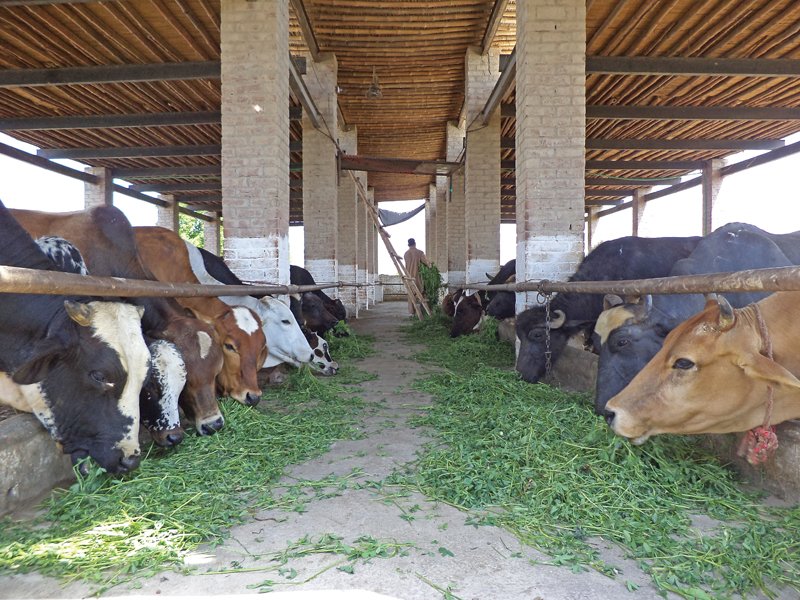
Many farmers are now adopting modern techniques – a much-needed development if the country wants to increase its dairy output and come on a par with international best practices.
“Our awareness of modern dairy farming has increased manifold and that’s the biggest advantage of this training,” Muhammad Anwar, a small farmer, told The Express Tribune during a training class at a corporate dairy farm in Kasur district.
Anwar is one of the many small farmers who are regularly taking training classes in modern dairy farming, which helps them increase yields, improve animal health and reduce calf mortality rate.
Despite being one of the top producers of milk with 50 million milk-giving animals, Pakistan has a very low yield. In fact, the country is not able to meet local demand.
A careful study of the dairy sector shows that small farmers contribute more than 90% of the country’s milk output and yet often lack knowledge of best feeding practices and animal health. They not only use primitive techniques but are also reluctant to change.
All this results in low milk yields and higher mortality rates for animals compared to more developed dairy farms, according to industry experts. However, slowly but surely, this tradition seems to be changing.
The dairy hubs and training classes set up by the corporate sector are transforming the way dairy farming is done in Pakistan, it was learnt during a visit to a dairy hub and some small farms that have shifted from traditional structure to the modern one.
“Before joining this training centre, I had limited to no knowledge of animal diseases nor was I aware of the antibiotics’ presence in milk,” Anwar said.
He acknowledged he would not only sell but also drink contaminated milk because of lack of awareness – something he stopped doing after learning about disease control and vaccination.
“The vets visit our farms frequently and provide us guidelines on animal feed and health. The quality of milk has improved significantly.”
Improved farming techniques are not the only benefit the farmers have gained. By working hand in hand with the corporate sector, they have learnt the language of finance.
Most farmers term the business knowhow one of the main advantages of the training.
“Milk collection agents never guided us about business expansion but now we have a clear knowledge of profit and loss,” said Naveed Ahmed, another farmer, attending the training class.
Animal’s offspring is their real bonus. By giving proper care, food and environment to the calves, he said, they were able to reduce mortality rate to less than 10% – for traditional farmers it is around 40%.
“Newly born calves need to be kept in nursery for a couple of days, exposed to certain temperature and given special feed,” Ahmed said, something he didn’t know before.
Applying modern techniques didn’t only improve animal health but also helped farmers increase their income.
“Compared to the past, the health of my animals improved significantly and so did my income,” said Syed Ashiq Hussain, who was expanding his farm, near Ellah Abad.
“If I have at least 50 animals, my profitability will improve,” he said, pointing to an open space he chose for setting up a shed for 50 animals.
With better business knowhow, the farmers have only become smarter as they go for expansion of business.
Akhtar Javed, who has a commercial dairy farm near Kanganpur, is a good example of that. Unlike past, he now makes sure the animal he is buying has a yield higher than 10 litres, otherwise, it doesn’t make a business case for him.
Javed, whose farm very much looks like a corporate dairy farm, even maintains the database of each of his animals and updates the record frequently. “I don’t buy animals with yield of three to four litres.”
An average cow in Pakistan produces around 1,300 litres of milk a year or 3.6 litres a day, while the average cow on a more advanced dairy farm, in the US for example, produces almost seven times more at about 9,000 litres.
The slow but steady increase in efficient farms is the beginning of the development of dairy farming infrastructure in Pakistan, say industry experts. It’s not that these animals don’t have capability, they need proper hygiene and care, they say.
“If a buffalo is giving five litres, it can’t go up to 25 litres in the next 15 days but achieving 10 litres in a couple of years is certainly possible,” an expert said.
Published in The Express Tribune, June 23rd, 2014.
Like Business on Facebook, follow @TribuneBiz on Twitter to stay informed and join in the conversation.
COMMENTS (3)
Comments are moderated and generally will be posted if they are on-topic and not abusive.
For more information, please see our Comments FAQ

















Even after this training etc; would suggest guys to take a trip to collection centers where these dairy farms are located...you will be shocked the way mixing is done and supported by so-called big companies to increase profits......they do not care about the health of the people...water , surf powder & low quality of ghee is mixed right under the nose of inspectors of the companies & govt....we cannot change the corrupt mindset of our people....the are fearless & do not seem to be even concerned of Allahs wrath...
@huma: True. But the govt can only go till the training step. The companies go till the end ie commercial exploration. That is why its more attractive for the farmers. Also, the companies lay down their own rules to buy a certain standard product.
Shame on the govt. Teaching best practices is the responsibility of the govt, not corporate sector. Shame, Shame.